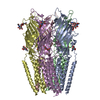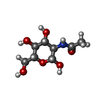+ Open data
Open data
- Basic information
Basic information
| Entry |  | |||||||||
|---|---|---|---|---|---|---|---|---|---|---|
| Title | Structure of a Cys-loop Receptor in Zinc Binding State | |||||||||
 Map data Map data | EM_map | |||||||||
 Sample Sample |
| |||||||||
 Keywords Keywords | Cys-loop Receptor / MEMBRANE PROTEIN | |||||||||
| Function / homology |  Function and homology information Function and homology informationpH-gated monoatomic ion channel activity / transmembrane transporter complex / ligand-gated monoatomic ion channel activity / response to zinc ion / ligand-gated monoatomic cation channel activity / extracellular ligand-gated monoatomic ion channel activity / transmembrane signaling receptor activity / monoatomic ion transmembrane transport / zinc ion binding / plasma membrane Similarity search - Function | |||||||||
| Biological species |  Homo sapiens (human) Homo sapiens (human) | |||||||||
| Method | single particle reconstruction / cryo EM / Resolution: 2.9 Å | |||||||||
 Authors Authors | Lu XH / Yang X / Shen YQ | |||||||||
| Funding support |  China, 1 items China, 1 items
| |||||||||
 Citation Citation |  Journal: Nat Commun / Year: 2025 Journal: Nat Commun / Year: 2025Title: Structural insights into the activation mechanism of the human zinc-activated channel. Authors: Xuhang Lu / Dongmei Li / Yaojie Wang / Gaohua Zhang / Tianlei Wen / Yue Lu / Nan Jia / Xuedi Wang / Shenghai Chang / Xing Zhang / Jianping Lin / Yu-Hang Chen / Xue Yang / Yuequan Shen /  Abstract: The zinc-activated channel (ZAC) is an atypical mammalian cys-loop receptor (CLR) that is activated by zinc ions and protons, allowing cations to pass through. The molecular mechanism that ligands ...The zinc-activated channel (ZAC) is an atypical mammalian cys-loop receptor (CLR) that is activated by zinc ions and protons, allowing cations to pass through. The molecular mechanism that ligands use to activate ZAC remains elusive. Here, we present three cryo-electron microscopy reconstructions of human ZAC (hZAC) under different conditions. These three hZAC structures display highly similar conformations to one another, forming symmetrical homo-pentamers with a central ion-conduction pore. The hZAC protomer comprises an extracellular domain (ECD) and a transmembrane domain (TMD), sharing more structural similarity with anion-permeable CLRs, such as glycine receptors and type A γ-aminobutyric acid receptors. Notably, hZAC possesses a distinctive C-tail that establishes a disulfide bond with the loop M2-M3 in the TMD and occupies what is typically the canonical neurotransmitter orthosteric site in other mammalian CLRs. Moreover, the tip of the cys-loop creates an unprecedented orthosteric site in hZAC. The binding of Zn triggers a conformational shift in the cys-loop, which presumably prompts the loop M2-M3 to move and open the channel gate. This study sheds light on the assembly of the channel, its structural features, and the process of signal transduction in hZAC. | |||||||||
| History |
|
- Structure visualization
Structure visualization
| Supplemental images |
|---|
- Downloads & links
Downloads & links
-EMDB archive
| Map data |  emd_39648.map.gz emd_39648.map.gz | 42.2 MB |  EMDB map data format EMDB map data format | |
|---|---|---|---|---|
| Header (meta data) |  emd-39648-v30.xml emd-39648-v30.xml emd-39648.xml emd-39648.xml | 18.5 KB 18.5 KB | Display Display |  EMDB header EMDB header |
| Images |  emd_39648.png emd_39648.png | 135.8 KB | ||
| Filedesc metadata |  emd-39648.cif.gz emd-39648.cif.gz | 6.2 KB | ||
| Others |  emd_39648_half_map_1.map.gz emd_39648_half_map_1.map.gz emd_39648_half_map_2.map.gz emd_39648_half_map_2.map.gz | 77.6 MB 77.6 MB | ||
| Archive directory |  http://ftp.pdbj.org/pub/emdb/structures/EMD-39648 http://ftp.pdbj.org/pub/emdb/structures/EMD-39648 ftp://ftp.pdbj.org/pub/emdb/structures/EMD-39648 ftp://ftp.pdbj.org/pub/emdb/structures/EMD-39648 | HTTPS FTP |
-Validation report
| Summary document |  emd_39648_validation.pdf.gz emd_39648_validation.pdf.gz | 1 MB | Display |  EMDB validaton report EMDB validaton report |
|---|---|---|---|---|
| Full document |  emd_39648_full_validation.pdf.gz emd_39648_full_validation.pdf.gz | 1 MB | Display | |
| Data in XML |  emd_39648_validation.xml.gz emd_39648_validation.xml.gz | 13 KB | Display | |
| Data in CIF |  emd_39648_validation.cif.gz emd_39648_validation.cif.gz | 15.4 KB | Display | |
| Arichive directory |  https://ftp.pdbj.org/pub/emdb/validation_reports/EMD-39648 https://ftp.pdbj.org/pub/emdb/validation_reports/EMD-39648 ftp://ftp.pdbj.org/pub/emdb/validation_reports/EMD-39648 ftp://ftp.pdbj.org/pub/emdb/validation_reports/EMD-39648 | HTTPS FTP |
-Related structure data
| Related structure data |  8yx6MC  8yx7C  8yx8C M: atomic model generated by this map C: citing same article ( |
|---|---|
| Similar structure data | Similarity search - Function & homology  F&H Search F&H Search |
- Links
Links
| EMDB pages |  EMDB (EBI/PDBe) / EMDB (EBI/PDBe) /  EMDataResource EMDataResource |
|---|---|
| Related items in Molecule of the Month |
- Map
Map
| File |  Download / File: emd_39648.map.gz / Format: CCP4 / Size: 83.7 MB / Type: IMAGE STORED AS FLOATING POINT NUMBER (4 BYTES) Download / File: emd_39648.map.gz / Format: CCP4 / Size: 83.7 MB / Type: IMAGE STORED AS FLOATING POINT NUMBER (4 BYTES) | ||||||||||||||||||||||||||||||||||||
|---|---|---|---|---|---|---|---|---|---|---|---|---|---|---|---|---|---|---|---|---|---|---|---|---|---|---|---|---|---|---|---|---|---|---|---|---|---|
| Annotation | EM_map | ||||||||||||||||||||||||||||||||||||
| Projections & slices | Image control
Images are generated by Spider. | ||||||||||||||||||||||||||||||||||||
| Voxel size | X=Y=Z: 0.93 Å | ||||||||||||||||||||||||||||||||||||
| Density |
| ||||||||||||||||||||||||||||||||||||
| Symmetry | Space group: 1 | ||||||||||||||||||||||||||||||||||||
| Details | EMDB XML:
|
-Supplemental data
-Half map: Half map B
| File | emd_39648_half_map_1.map | ||||||||||||
|---|---|---|---|---|---|---|---|---|---|---|---|---|---|
| Annotation | Half_map_B | ||||||||||||
| Projections & Slices |
| ||||||||||||
| Density Histograms |
-Half map: Half map A
| File | emd_39648_half_map_2.map | ||||||||||||
|---|---|---|---|---|---|---|---|---|---|---|---|---|---|
| Annotation | Half_map_A | ||||||||||||
| Projections & Slices |
| ||||||||||||
| Density Histograms |
- Sample components
Sample components
-Entire : Cys-loop Receptor in Zinc Binding State
| Entire | Name: Cys-loop Receptor in Zinc Binding State |
|---|---|
| Components |
|
-Supramolecule #1: Cys-loop Receptor in Zinc Binding State
| Supramolecule | Name: Cys-loop Receptor in Zinc Binding State / type: complex / ID: 1 / Parent: 0 / Macromolecule list: #1 |
|---|---|
| Source (natural) | Organism:  Homo sapiens (human) Homo sapiens (human) |
| Molecular weight | Theoretical: 230 KDa |
-Macromolecule #1: Ligand-gated cation channel ZACN
| Macromolecule | Name: Ligand-gated cation channel ZACN / type: protein_or_peptide / ID: 1 / Number of copies: 5 / Enantiomer: LEVO |
|---|---|
| Source (natural) | Organism:  Homo sapiens (human) Homo sapiens (human) |
| Molecular weight | Theoretical: 46.858117 KDa |
| Recombinant expression | Organism:  Homo sapiens (human) Homo sapiens (human) |
| Sequence | String: MMALWSLLHL TFLGFSITLL LVHGQGFQGT AAIWPSDYKD DDDKLFNVNL SKKVQESIQI PNNGSAPLLV DVRVFVSNVF NVDILRYTM SSMLLLRLSW LDTRLAWNTS AHPRHAITLP WESLWTPRLT ILEALWVDWR DQSPQARVDQ DGHVKLNLAL A TETNCNFE ...String: MMALWSLLHL TFLGFSITLL LVHGQGFQGT AAIWPSDYKD DDDKLFNVNL SKKVQESIQI PNNGSAPLLV DVRVFVSNVF NVDILRYTM SSMLLLRLSW LDTRLAWNTS AHPRHAITLP WESLWTPRLT ILEALWVDWR DQSPQARVDQ DGHVKLNLAL A TETNCNFE LLHFPRDHSN CSLSFYALSN TAMELEFQAH VVNEIVSVKR EYVVYDLKTQ VPPQQLVPCF QVTLRLKNTA LK SIIALLV PAEALLLADV CGGLLPLRAI ERIGYKVTLL LSYLVLHSSL VQALPSSSSC NPLLIYYFTI LLLLLFLSTI ETV LLAGLL ARGNLGAKSG PSPAPRGEQR EHGNPGPHPA EEPSRGVKGS QRSWPETADR IFFLVYVVGV LCTQFVFAGI WMWA ACKSD AAPGEAAPHG RRPRL UniProtKB: Ligand-gated cation channel ZACN |
-Macromolecule #3: 2-acetamido-2-deoxy-beta-D-glucopyranose
| Macromolecule | Name: 2-acetamido-2-deoxy-beta-D-glucopyranose / type: ligand / ID: 3 / Number of copies: 5 / Formula: NAG |
|---|---|
| Molecular weight | Theoretical: 221.208 Da |
| Chemical component information |  ChemComp-NAG: |
-Macromolecule #4: ZINC ION
| Macromolecule | Name: ZINC ION / type: ligand / ID: 4 / Number of copies: 10 / Formula: ZN |
|---|---|
| Molecular weight | Theoretical: 65.409 Da |
-Experimental details
-Structure determination
| Method | cryo EM |
|---|---|
 Processing Processing | single particle reconstruction |
| Aggregation state | particle |
- Sample preparation
Sample preparation
| Concentration | 10 mg/mL |
|---|---|
| Buffer | pH: 7.5 |
| Vitrification | Cryogen name: ETHANE / Chamber humidity: 100 % / Chamber temperature: 288 K / Instrument: FEI VITROBOT MARK IV |
- Electron microscopy
Electron microscopy
| Microscope | FEI TITAN KRIOS |
|---|---|
| Image recording | Film or detector model: FEI FALCON IV (4k x 4k) / Average electron dose: 50.0 e/Å2 |
| Electron beam | Acceleration voltage: 300 kV / Electron source:  FIELD EMISSION GUN FIELD EMISSION GUN |
| Electron optics | C2 aperture diameter: 70.0 µm / Illumination mode: FLOOD BEAM / Imaging mode: BRIGHT FIELD / Cs: 2.7 mm / Nominal defocus max: 2.0 µm / Nominal defocus min: 1.3 µm |
| Sample stage | Specimen holder model: FEI TITAN KRIOS AUTOGRID HOLDER / Cooling holder cryogen: NITROGEN |
| Experimental equipment |  Model: Titan Krios / Image courtesy: FEI Company |
 Movie
Movie Controller
Controller








 Z (Sec.)
Z (Sec.) Y (Row.)
Y (Row.) X (Col.)
X (Col.)




































